Simulation-Based Tsunami Evacuation Training Framework Aimed at Avoiding the Negative Consequences of Using Cars
Abstract
1. Introduction
1.1. Pilot Study Sites and Framework Design
1.2. Objectives and Research Hypotheses
- A VR tsunami simulator that provides firsthand experience of congestion and delays during vehicle evacuation.
- A KYT-based mobile app that uses quiz-style scenarios and gamified feedback to train users in hazard recognition.
- To develop and validate a VR tsunami evacuation simulator that helps people understand the risks and alternatives to car evacuation.
- To design and evaluate a KYT-based mobile application that improves hazard detection and evacuation decision-making.
- Hypothesis 1: Simulator training will increase willingness to evacuate on foot, especially when a nearby shelter is available.
- Hypothesis 2: The KYT-based app may enhance participants’ awareness of traffic hazards during evacuation as suggested by their subjective feedback and observable gaze behavior.
2. Materials and Methods
- Simulator development;
- Pilot study in Ishinomaki City to confirm that the simulator is a valuable tool in tsunami evacuation and to obtain data during evacuation;
- Development of KYT-based application based on the obtained data from the pilot study in Ishinomaki City;
- Conduct experiment in Nishio City to verify the effect of the KYT-based application.
2.1. Simulator Design and Experimental Setup
2.2. Pilot Study in Ishonomaki City
- Test explanation and signing of the experimental consent form (approximately 15 min).
- Evacuation by car (two trials, one for data acquisition, approximately 5 min each).Two trials were conducted before the data acquisition phase because the participants had yet to experience the tsunami evacuation simulator; they needed to become familiar with driving in the simulator and operating the steering controller. In addition, this was their first time going around the area of Nishio City as reproduced by the simulator; therefore, they also were required to understand the evacuation route. In the data acquisition phase, participants were instructed to evacuate along the same route as in the trials under the condition that the voice of the emergency broadcast was played to urge participants to evacuate quickly from the tsunami. Here, each participant was instructed to evacuate within 20 min, and the remaining time for evacuation is shown in the lower right corner of the screen in Figure 3a.
- Evacuation on foot (one trial, one data acquisition, approximately 5 min each).Because none of the participants had previously experienced VR, they needed to become familiar with walking in the VR setting. Therefore, a trial was conducted before data acquisition. In the data acquisition phase, as in the case of evacuation by car, participants were instructed to evacuate along the same route as in the trials, under the condition that the voice of the emergency broadcast was played and the time of arrival for tsunami was displayed. Each participant was instructed to evacuate within 20 min, and the remaining time for evacuation is shown in the lower right corner of the screen in Figure 3b.
- Questionnaire.After testing, all participants were asked about their feelings regarding the reality of the tsunami evacuation simulator and their thoughts on using cars for tsunami evacuation. At the current technical level, creating a virtual world that can be recognized as accurate by the participants is impossible, making it difficult to completely reproduce the sense of urgency of an actual tsunami evacuation. Thus, the term “reality” is used for the traffic situation and behavior of the traffic participants specific to this study.
2.3. KYT-Based Application Development
2.4. Experimental Procedure in Nishio City
- Participants filled an experimental consent form after the experiment was explained. All participants were informed that they could decline to participate, even during the test.
- Participants sat on a chair and adjusted their seating positions to use the simulator.
- The eye tracker (Tobii Pro Nano) was calibrated.
- Participants were instructed on the route to use for evacuation.
- Before data acquisition, the participants drove freely along the indicated route as a trial to familiarize themselves with the driving mode of the simulator.
- Participant data were obtained on evacuation behavior when using cars. Here, each participant was instructed to evacuate within 20 min; the remaining time for evacuation is shown in the lower right corner of the screen in Figure 3a. (Steps 5 and 6 correspond to the “Evacuation by car” experiments conducted in Ishinomaki City as outlined in Section 2.2.)
- After a five min break, the participants wore an HMD connected to the simulator.
- Participants walked freely along the indicated route to familiarize themselves with the operation of the pedestrian mode of the simulator.
- Data were collected on the evacuation behavior of the participants on foot. Here, each participant was instructed to re-evacuate within 20 min, and the remaining time for evacuation is shown in the lower right corner of the screen in Figure 3b. (Steps 8 and 9 correspond to the “Evacuation on foot” experiments conducted in Ishinomaki City as outlined in Section 2.2.)
- Participants were asked to complete a questionnaire on their awareness of tsunami evacuation.
- Participants were taught to use the KYT-based application, choose the device they preferred to use (smartphone or tablet), and take the smartphone or tablet home. The participants were also asked to comment on the application’s usability during or after using the KYT-based application for purposes of improvement.
- Six days after the simulator experience, the participants attempted to acquire knowledge about safe evacuation using the KYT-based application on the selected device.
- Participants then re-experienced the tsunami evacuation simulation. Steps 2–10 of the experimental procedure were repeated.
- Participants completed a questionnaire designed to investigate changes in their awareness of tsunami evacuation owing to the use of the KYT-based application.
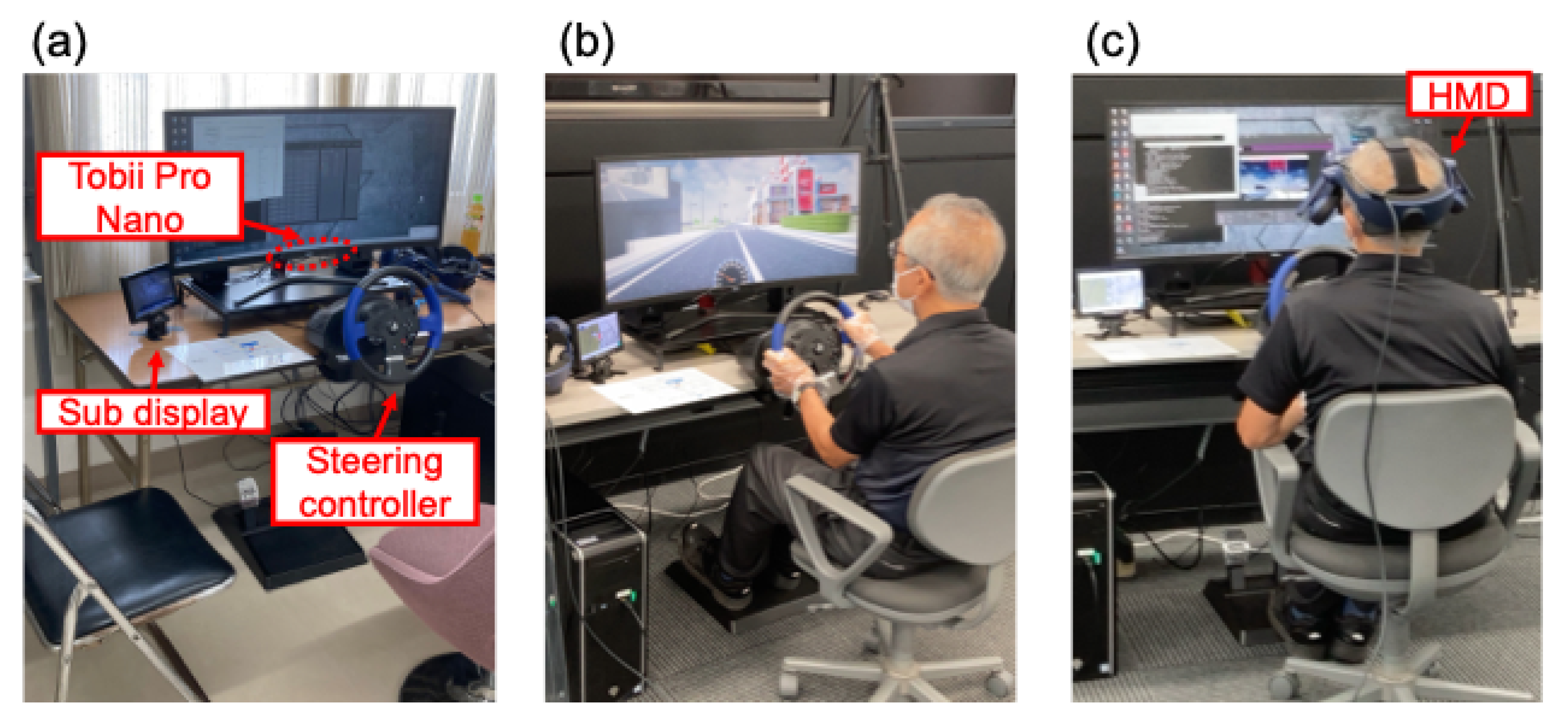
3. Results and Discussion
3.1. Findings from Experiment in Ishinomaki City
- Participants with prior tsunami evacuation experience frequently checked traffic signals to evaluate the situation and determine whether traffic was flowing normally.
- Such experienced participants also tended to look tall or had prominent builds which helped them in orienting themselves toward their destination or identifying alternative safe locations for rapid evacuation.
- While evacuating by car, these participants often failed to notice pedestrians at crosswalks, as their visual attention was more focused on traffic signals, surrounding vehicles, and tall buildings rather than on pedestrians.
3.2. Result of Experiment in Nishio City
| Target Area | Evacuation by Car | Evacuation on Foot |
|---|---|---|
| Signboard | 0.000 | −0.129 |
| Inner rearview mirror | 0.075 | – |
| Evacuation sign | 0.119 | 0.072 |
| Prominent building and emergency refuge | −0.046 | 0.180 |
| Traffic signal | 0.443 | 0.126 |
| Police officer guiding the route | −0.373 | −0.655 |
3.3. Discussion on Behavioral Change and Training Effectiveness
4. Limitations of the Work
5. Conclusions
Author Contributions
Funding
Institutional Review Board Statement
Data Availability Statement
Acknowledgments
Conflicts of Interest
Abbreviations
| AR | Augmented reality |
| HMD | Head-mounted display |
| ICT | Information and Communication Technology |
| KYT | Kiken Yochi Training |
| VR | Virtual reality |
Appendix A
| Participant | Before the Experiment on the Tsunami Evacuation Simulator (Before Training on KYT-Based Application) | After the Experiment on the Tsunami Evacuation Simulator (After Training on KYT-Based Application) |
|---|---|---|
| A | Keep calm. | In addition to evacuating, pay attention to people, buildings, and cars around me. |
| B | I am worried about whether I will have the physical strength to evacuate to the evacuation site on foot. I make it a habit to always walk. | I am worried about whether I will have the physical strength to evacuate to the evacuation site on foot. I make it a habit to always walk. |
| C | In the simulator, a child evacuates alone. I wondered if I should take him/her together with me. | Act calmly and quickly. |
| D | At first, I would think about whether I should evacuate by car or on foot, and I would need to have information such as the time of arrival of the Tsunami. | Act with calmness, and evacuate according to the evacuation guidelines paying attention to the persons around me. |
| E | Notice things around me when evacuating because I am not evacuating alone. Do not approach a building about to collapse. | Be aware of traffic, because I am not evacuating alone. |
| F | Evacuate along the shortest distance to an area outside that flooded by the tsunami. | N/A |
| G | Consider multiple evacuation routes, as collapsed houses and concrete walls may impede passage. | I think I would need to pay attention to the time and traffic around me, especially people. |
| H | Avoid traffic accidents during evacuation. | Evacuate far away, and if not, to a higher location. |
| I | Notice time and evacuation place. | Evacuate to the evacuation place by noticing things around me. |
| J | Be careful as trees and structures may have fallen on the road Traffic lights are broken, so watch out for cars and pedestrians Evacuate on time | Watch out for pedestrians and other vehicles as traffic lights are broken Listen carefully to the instructions of the person guiding you Look at a building and know where you are |
| K | Because we will be evacuating on foot, I am trying to find the shortest route to our destination. | N/A |
| L | Notice the place where persons and/or cars rush out, and whether a building is about to collapse. | Understand the evacuation place in advance. |
| M | Pay close attention to the movement of vehicles and people. The first thing is to know the evacuation site well. | Hazardous areas, surrounding conditions, etc. |
| N | Depending on the situation, evacuate on foot toward the north. Check where your evacuation place is. Minimize the amount of luggage you carry and give priority to evacuation. | I think we should be careful not to give priority only to evacuating quickly because a tsunami is coming but to comprehensively and safely evacuate based on a holistic understanding of the situation. |
| O | Evacuate while considering how far to evacuate before a tsunami hits. Choose a safe route that is not flooded or destroyed by the tsunami. Evacuate so as not to be involved in an accident with a car or motorcycle. Evacuate with a minimum amount of water, food, and valuables in a backpack. | Secure evacuation routes and be careful not to run into accidents with vehicles, etc. |
| P | When
evacuating by car, you must be careful not to cause an accident because cars will proceed regardless of traffic signals. When evacuating on foot, do not be careless just because there is a pedestrian crossing; accidents can occur if you do not look carefully. Decide the evacuation site and route in advance to allow plenty of time for evacuation. As flooding is possible, I think it is better to wear athletic shoes when evacuating. |
Notice cars, bicycles, signboards, large
targets, connections, tsunami temporary evacuation place, traffic signals, and the flow of people. |
| Q | When
evacuating by car, it may be difficult to proceed due to the number of cars. If I am on foot, I have to watch out for cars turning to cross the road. |
It is important to use large buildings
and other landmarks to confirm my location because the appearance may be different from normal times. |
| R | Move
more cautiously because the road conditions are different from usual. Traffic signals are not likely to be functioning. |
Notice cars, bicycles, signboards, large
targets, connections, tsunami temporary evacuation place, traffic signals, and the flow of people. |
| S | Make
decisions and take prompt action.
Also, talk to the people around when evacuating. I hope that I am safe first, I will be able to help more people in the next stage. | N/A |
| T | Check
nearby evacuation sites immediately
Listen carefully when announcements are made on the town’s public address system. When a traffic light goes off, look around carefully and cross the street. If there are police officers, follow their instructions. Check the source of fire at least once because there is a time lag between the earthquake and tsunami. | Be
aware of surroundings, as both vehicles and pedestrians may behave differently than usual. During evacuation, look at the surrounding buildings and check your location carefully. It is also a good idea to be flexible about where to take shelter. |
| U | When
evacuating on foot, walk on sidewalks. When crossing the street, cross on the sidewalk after checking both sides. When evacuating by car, be aware of the distance between cars in front of me. When there is a pedestrian crossing, check for pedestrians on both sides of the road and drive slowly. | Contact
with bicycle evacuees during a walking evacuation.
Checking for vehicles on the left and right when crossing the road. Confirmation of bicycles on both sides of the road. Checking the flow of people to the evacuation site. Check for vehicles and bicycles on the left, right, front and rear at intersections. Do not evacuate by walking along the river. |
| V | N/A | Confirmation
to evacuation site
Although there were no images in the “Training Application,” anxiety about evacuation by walking, especially for weather and time (late at night). Anxiety about pedestrians at intersections and vehicular traffic from the front and rear on the left and right |
| W | Make
sure to determine evacuation routes and check hazardous areas on a daily basis. Check hazard maps for flooding conditions up to evacuation sites. It is important to be prepared on a daily basis so that I can start evacuation as soon as possible. |
Since each person has his/her own
evacuation method and route, I thought it was important to evacuate calmly while looking around carefully and assuming various things. |
| X | State
of liquefaction of the road Shortest route to where to escape Collapsed houses and damaged power lines | Bicycle
and car traffic from side streets, vehicles coming up behind me. Being aware of my position by signs and buildings. The flow of people ahead of me |
| Y | If evacuating on foot, avoid being hit by cars Watch out for falling objects. Stay away from dangerous objects such as gas stations and downed power lines. When evacuating by car, be careful not to run over people. Be especially careful at intersections because traffic lights may not be working. | I think we need to understand that the situation is different from our daily life, and we need to evacuate while anticipating what dangers may be present. |
References
- Miura, N.; Yasuhara, K.; Kawagoe, S.; Yokoi, H.; Kazama, S. Damage from the Great East Japan earthquake and tsunami—A quick report. Mitig. Adapt. Strateg. Glob. Change 2011, 16, 803–818. [Google Scholar] [CrossRef]
- Fujita, M.; Hamaguchi, N.; Kameyama, Y. Process of recovery from the Great East Japan earthquake which pictures and data. In Spatial Economics for Building Back Better; Springer: Singapore, 2021; pp. 75–98. [Google Scholar]
- Murakami, H.; Takimoto, K.; Pomonis, A. Tsunami evacuation process and human loss distribution in the 2011 Great East Japan earthquake—A case study of Natori city, Miyagi prefecture. In Proceedings of the 15th World Conference on Earthquake Engineering, Lisbon, Portugal, 24–28 September 2012; pp. 1–10. [Google Scholar]
- Hara, Y.; Kuwahara, M. Traffic monitoring immediately after a major natural disaster revealed by probe data—A case in Ishinomaki after the Great East Japan earthquake. Transp. Res. Part A Policy Pract. 2015, 75, 1–15. [Google Scholar] [CrossRef]
- Takabatake, T.; Fujisawa, K.; Esteban, M.; Shibayama, T. Simulated effectiveness of a car evacuation from a tsunami. Int. J. Disaster Risk Reduct. 2020, 47, 101532. [Google Scholar] [CrossRef]
- Cabinet Office, Government of Japan. Measures to Ensure Safe and Secure Evacuation by Car. Cabinet Office, Government of Japan Website. 2012. Available online: https://www.bousai.go.jp/jishin/tsunami/hinan/5/pdf/3.pdf (accessed on 26 May 2025). (In Japanese).
- Sasaki, M.; Ujihara, T.; Abe, H.; Suzuki, R. Intention of car use, its motive and reduction potential by various policies based on the assumption of evacuation from tsunami disaster generated by Nankai Trough earthquake. J. City Plan. Inst. Jpn. 2014, 49, 861–866. (In Japanese) [Google Scholar] [CrossRef]
- Takei, H.; Okumura, M. Risk of being caught by tsunami and traffic accident risk in vehicle–pedestrian mixed evacuation. JSTE J. Traffic Eng. 2018, 4, A_129–A_137. (In Japanese) [Google Scholar]
- Mas, E.; Suppasri, A.; Iwamura, F.; Koshimura, S. Agent-based simulation of the 2011 Great East Japan earthquake/tsunami evacuation: An integrated model of tsunami inundation and evacuation. J. Nat. Disaster Sci. 2012, 34, 41–57. [Google Scholar] [CrossRef]
- Aguilar, L.; Wijerathne, L.; Ichimura, T.; Hori, M. Mixed mode large urban area tsunami evacuation considering car–pedestrian interactions. J. Jpn. Soc. Civ. Eng. Ser. A2 Appl. Mech. 2015, 71, I_633–I_641. [Google Scholar] [CrossRef] [PubMed]
- Learning Guild. Learning Leaders: Julie Dirksen on the Importance of Feedback in Changing Behavior. 2017. Available online: https://www.learningguild.com/articles/2220/learning-leaders-julie-dirksen-on-the-importance-of-feedback-in-changing-behavior/?rd=1 (accessed on 26 May 2025).
- Leeper, M.R. Microcomputers in education: Motivational and social issues. Am. Psychol. 1985, 40, 1–18. [Google Scholar] [CrossRef]
- Learning Guild. VR: A Promising Environment for Behavior Change Training. 2019. Available online: https://www.learningguild.com/articles/vr-a-promising-environment-for-behavior-change-training/?rd=1 (accessed on 26 May 2025).
- Petersen, G.B.; Klingenberg, S.; Mayer, R.E.; Makransky, G. The virtual field trip: Investigating how to optimize immersive virtual learning in climate change education. Br. J. Educ. Technol. 2020, 51, 2009–2115. [Google Scholar] [CrossRef]
- West, R.; Michie, S. A Brief Introduction to the COM-B Model of Behavior and the PRIME Theory of Motivation. Open Peer Rev Qiops. 2020. Available online: https://discovery.ucl.ac.uk/id/eprint/10095640/1/WW04E6.pdf (accessed on 25 May 2025).
- Checa, D.; Bustillo, A. A review of immersive virtual reality serious games to enhance learning and training. Multimed. Tools Appl. 2020, 79, 5501–5527. [Google Scholar] [CrossRef]
- Maruyama, Y.; Sakaki, S. Driving simulator experiment on vehicular evacuation during tsunami. In Proceedings of the 16th World Conference on Earthquake Engineering (16WCEE), Santiago, Chile, 9–13 January 2017; pp. 1–8. [Google Scholar]
- Feng, Z.; Liu, C.; González, V.A.; Lovreglio, R.; Nilsson, D. Prototyping an immersive virtual reality training system for urban-scale evacuation using 360-degree panoramas. IOP Conf. Ser. Earth Environ. Sci. 2020, 1101, 022037. [Google Scholar] [CrossRef]
- Doungutha, C.; Theppituck, T. The development of a virtual reality adventure game to prepare for a tsunami disaster. J. Graph. Eng. Des. 2023, 14, 5–14. [Google Scholar] [CrossRef]
- Fukada, K. Why Social Games Are Addictive—Gamification Changes Customer Satisfaction; SB Creative Corp: Tokyo, Japan, 2012. (In Japanese) [Google Scholar]
- Leelawat, N.; Suppasri, A.; Latcharote, P.; Abe, Y.; Sugiyasu, K.; Imamura, F. Tsunami evacuation experiment using a mobile application: A design science approach. Int. J. Disaster Risk Reduct. 2018, 29, 63–72. [Google Scholar] [CrossRef]
- Sugiyama, T.; Yamori, K. Development and social implementation of the “Nige-Tore” smartphone app for improving tsunami evacuation drills: Synergistic interactions between “commitment” and “contingency”. Jpn. J. Exp. Soc. Psychol. 2019, 58, 135–146. (In Japanese) [Google Scholar] [CrossRef]
- Miyoshi, N.; Mitsuhara, H.; Shishibori, M. Location-based game for learning how to survive tsunami. In Proceedings of the Forum on Information Technology 2020, Sapporo, Japan, 1–3 September 2020; pp. 371–374. (In Japanese). [Google Scholar]
- Yamori, K.; Sugiyama, T. Development and social implementation of smartphone app Nige-Tore for improving tsunami evacuation drills: Synergistic effects between commitment and contingency. Int. J. Disaster Risk Sci. 2020, 11, 751–761. [Google Scholar] [CrossRef]
- Matsuno, Y.; Fukanuma, F.; Tsuruoka, S. Development of flood disaster prevention simulation smartphone application using gamification. In Dynamics of Disasters: Impact, Risk, Resilience, and Solutions; Springer Nature: Cham, Switzerland, 2021; pp. 147–159. [Google Scholar]
- Han, D.C.; Takabatake, T.; Esteban, M.; Shibayama, T. Development of smartphone application to support tsunami evacuation. Coast. Eng. Proc. 2022, 37, 38. [Google Scholar] [CrossRef]
- Han, D.C.; Takabatake, T.; Esteban, M.; Shibayama, T. Development and implementation of a smartphone application for tsunami evacuation. Int. J. Disaster Risk Reduct. 2023, 96, 103915. [Google Scholar] [CrossRef]
- Mitsuhara, H.; Shishibori, M. Tsunami evacuation drill system focusing on mobile devices. Int. J. Interact. Mob. Technol. 2022, 16, 4–20. [Google Scholar] [CrossRef]
- Han, H.; Kim, S.; Choi, J.; Park, H.; Yang, J.H.; Kim, J. Driver’s avoidance characteristics to hazardous situations: A driving simulator study. Transp. Res. Part F 2021, 81, 522–539. [Google Scholar] [CrossRef]
- Hori, T. A statistical model of temporal variation of seismicity in the inner zone of southwest Japan related to the great interplate earthquakes along the Nankai Trough. J. Phys. Earth 1996, 44, 349–356. [Google Scholar] [CrossRef]
- Ministry of Land, Infrastructure, Transport and Tourism Chubu Regional Development Bureau. Earthquake and Tsunami Countermeasures Initiatives in Nishio City. 2013. Available online: https://www.cbr.mlit.go.jp/kensei/machi_seibika/pdf/20130816_shizuoka04_nishio.pdf (accessed on 26 May 2025). (In Japanese).
- Nishio City. 170,000 Citizens Wholehearted Disaster Prevention Drill. 2023. Available online: https://www.city.nishio.aichi.jp/_res/projects/default_project/_page_/001/008/241/202310all2.pdf (accessed on 26 May 2025). (In Japanese).
- Arakawa, T.; Obayashi, F.; Kobayashi, K.; Itamiya, T.; Uno, S.; Yamabe, S.; Suzuki, T. New Tsunami Evacuation Training Methods: A Tsunami Evacuation Training Application. Geosciences 2024, 13, 110. [Google Scholar] [CrossRef]
- Misaki Design LLC. Homepage. 2022. Available online: http://misaki-design.co.jp/ (accessed on 26 May 2025).
- Aichi Prefecture. Aichi Prefecture Municipal Tsunami Evacuation Planning Guidelines. 2020. Available online: https://www.pref.aichi.jp/bousai/thunamihinankeikakusakuteisishin.pdf (accessed on 26 May 2025). (In Japanese).
- Arakawa, T.; Yamabe, S.; Obayashi, F.; Suzuki, T.; Kobayashi, K.; Itamiya, T.; Uno, S.; Tajima, A. Proposal of a Tsunami Evacuation Drill Method Using a Simulator: Verification of the Validity of a Tsunami Evacuation Drill Simulator System. J. Jpn. Soc. Nat. Disaster 2022, 20, 251–261. (In Japanese) [Google Scholar]
- Google. Google Map. 2025. Available online: http://maps.google.co.jp/ (accessed on 26 May 2025).
- Ito, K.; Taguchi, H.; Fujinami, K. Posing questions during experimental operations for safety training in university chemistry experiments. Int. J. Multimed. Ubiquitous Eng. 2014, 9, 51–62. [Google Scholar]
- Noor, A.Y.; Irniza, R.; Emilia, Z.A.; Anita, A.R.; Suriani, I. Kiken Yochi Training (KYT) in reducing accidents at workplaces: A systematic review. Int. J. Public Health 2016, 3, 123–132. [Google Scholar]
- Chen, Q.; Jin, R. Safety4Site commitment to enhance jobsite safety management and performance. J. Constr. Eng. Manag. 2012, 138, 509–519. [Google Scholar] [CrossRef]
- Japan International Center for Occupational Safety and Health. Concept of Zero-Accident Total Participation Campaign. 2013. Available online: https://warp.ndl.go.jp/info:ndljp/pid/13728025/www.jisha.or.jp/international/jicosh/english/osh/outline/index.html (accessed on 26 May 2025).
- Hashida, M.; Kamezaki, R.; Goto, M.; Shirahashi, J. Quantification of hazard prediction ability at hazard prediction training (Kiken-Yochi Training: KYT) by free-response receiver-operating characteristic (FROC) analysis. Radiol. Phys. Technol. 2017, 10, 106–112. [Google Scholar] [CrossRef]
- Ikeda, N.; Kagechika, K.; Maeno, T. The effect of nurses’ training on sensitivity of fall risk prediction (KYT: Kiken Yochi training). Ann. Phys. Rehabil. Med. 2018, 61, e530. [Google Scholar]
- Hidaka, A.; Miyake, A. Selection of suitable safety activities and experience of safety condition establishment. Open J. Saf. Sci. Technol. 2015, 5, 1–9. [Google Scholar] [CrossRef]
- Ministry of Education, Culture, Sports, Science and Technology. Official Educational Safety Materials. 2022. Available online: https://anzenkyouiku.mext.go.jp/todoufuken/data/35yamaguchi/35-03/35-03-1.pdf (accessed on 3 May 2025).
- Ren, G.; Huang, Z.; Cheng, Y.; Zhao, X.; Zhang, Y. An integrated model for evacuation routing and traffic signal optimization with background demand uncertainty. J. Adv. Transp. 2013, 47, 4–27. [Google Scholar] [CrossRef]
- Chen, M.; Chen, L.; Miller-Hooks, E. Traffic signal timing for urban evacuation. J. Urban Plann. Dev. 2007, 133, 30–42. [Google Scholar] [CrossRef]
- NHK. NHK Archives. 2024. Available online: https://www2.nhk.or.jp/archives/articles/?id=C0070066 (accessed on 2 August 2025). (In Japanese).





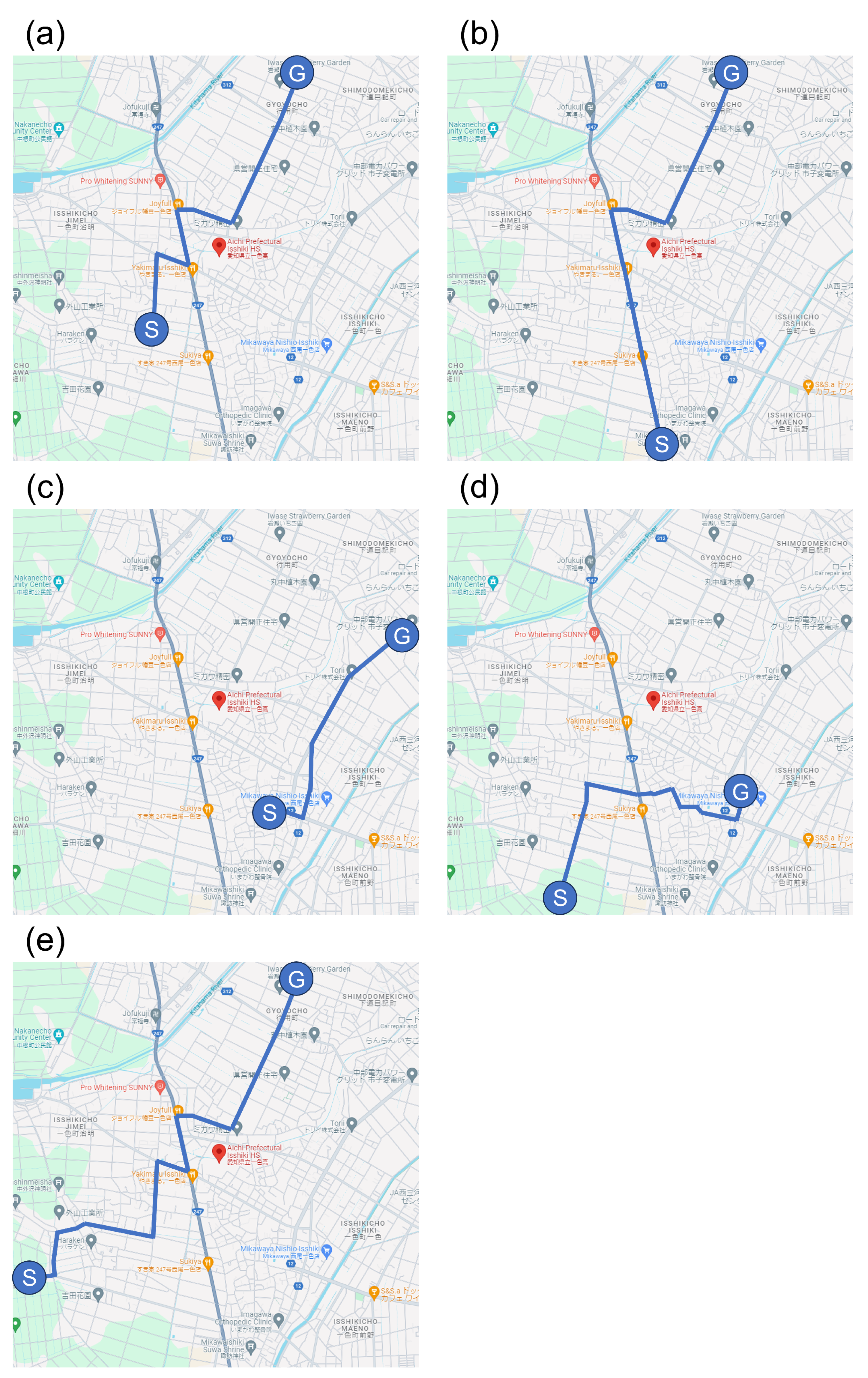
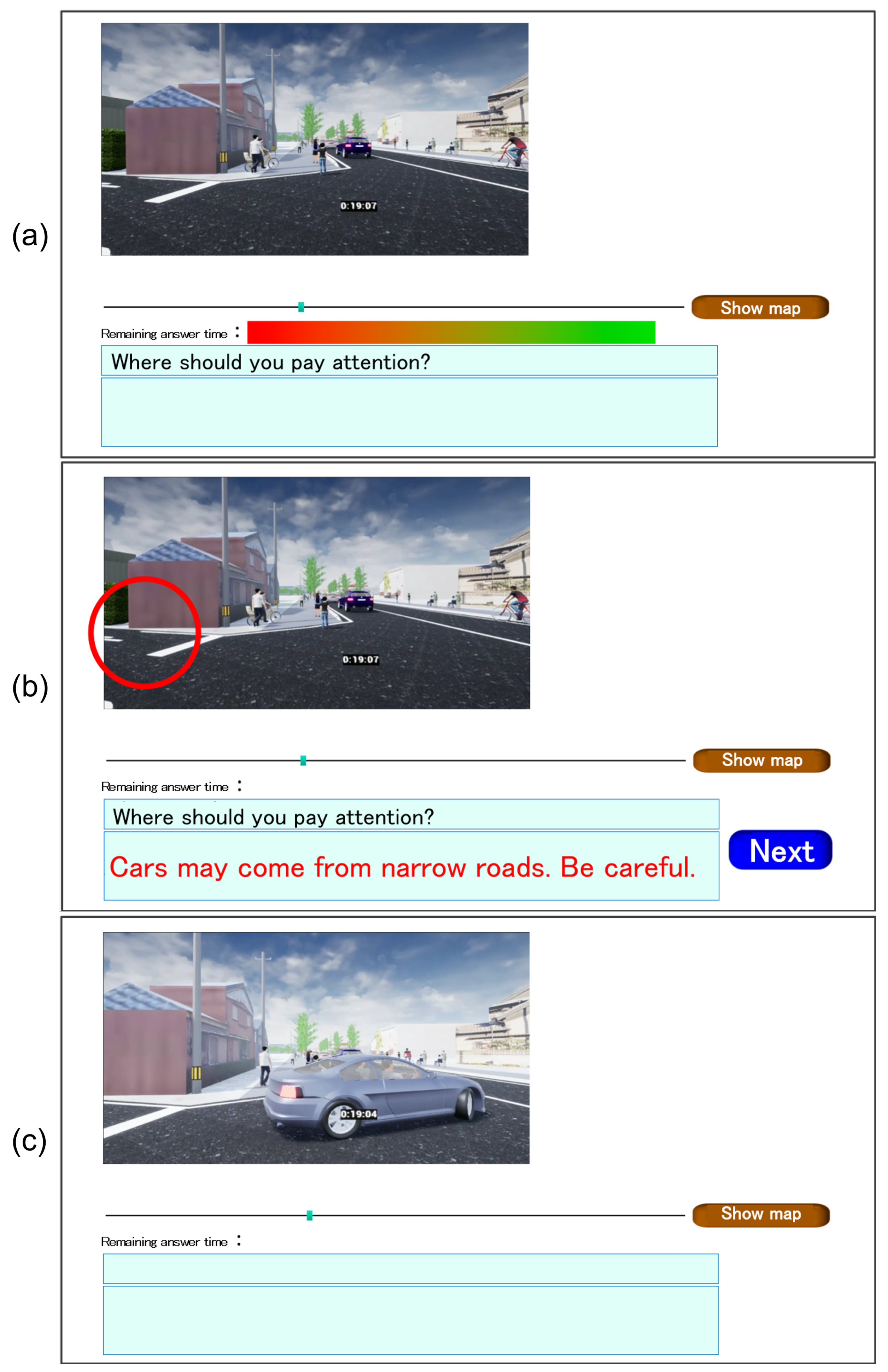
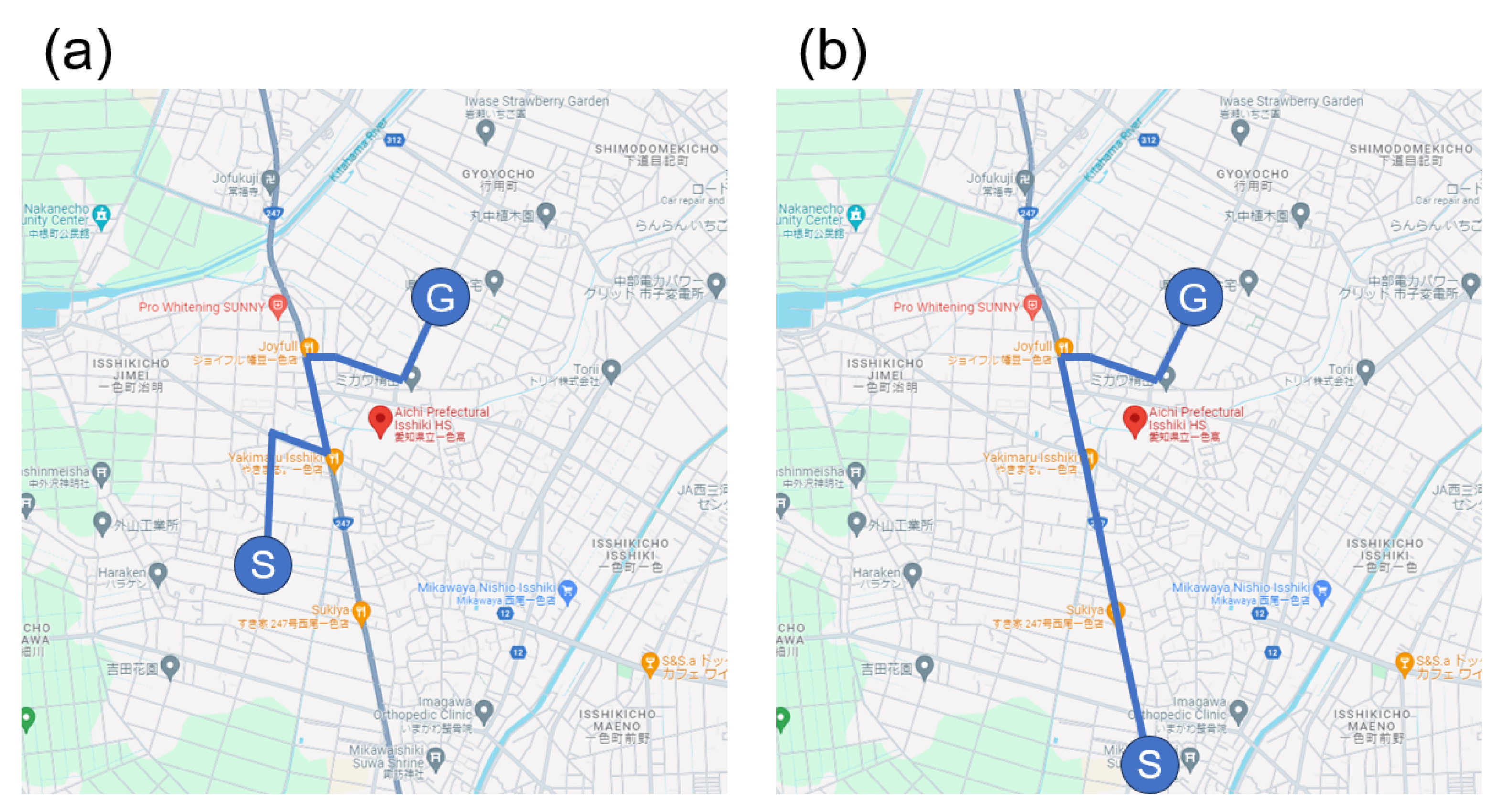
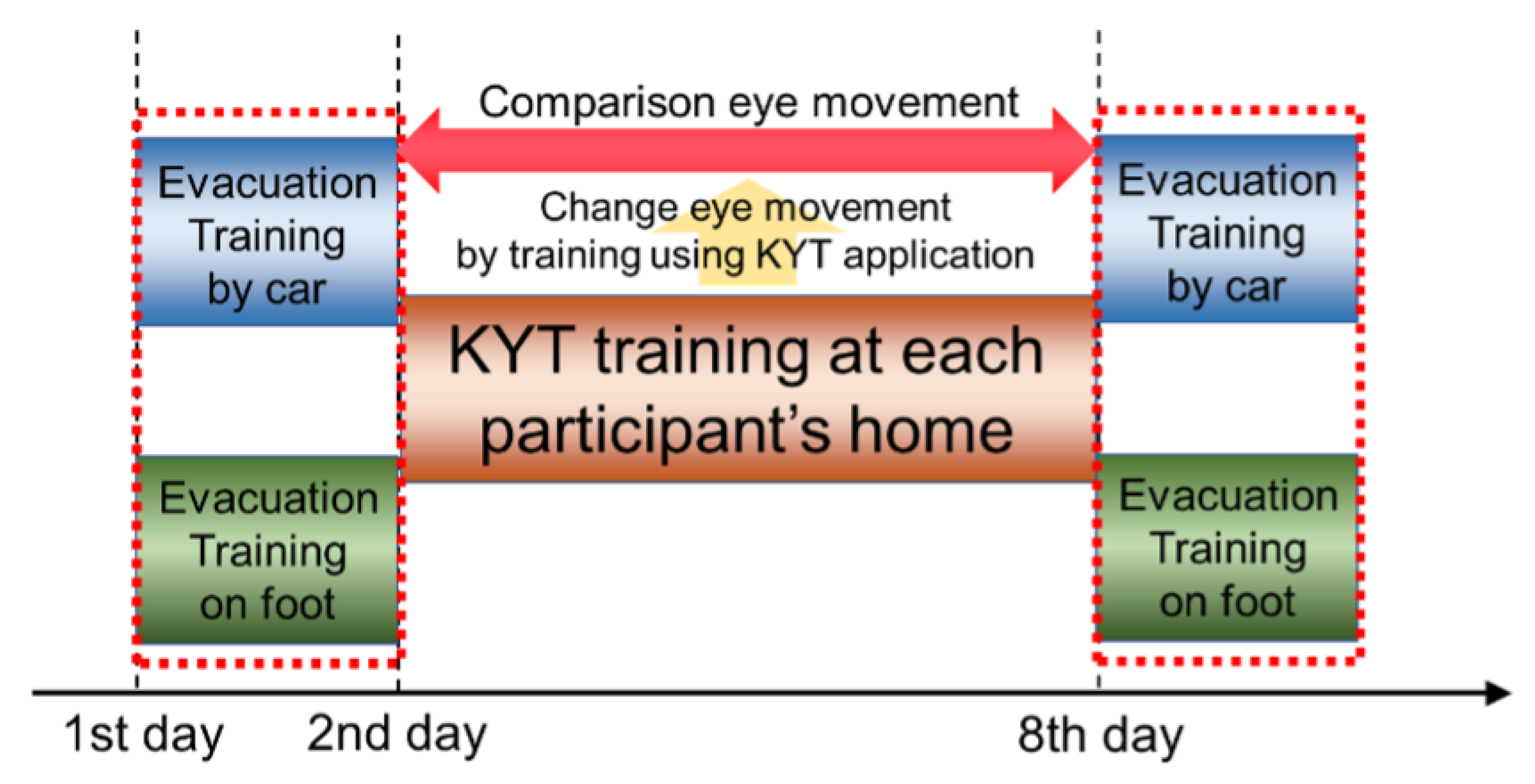
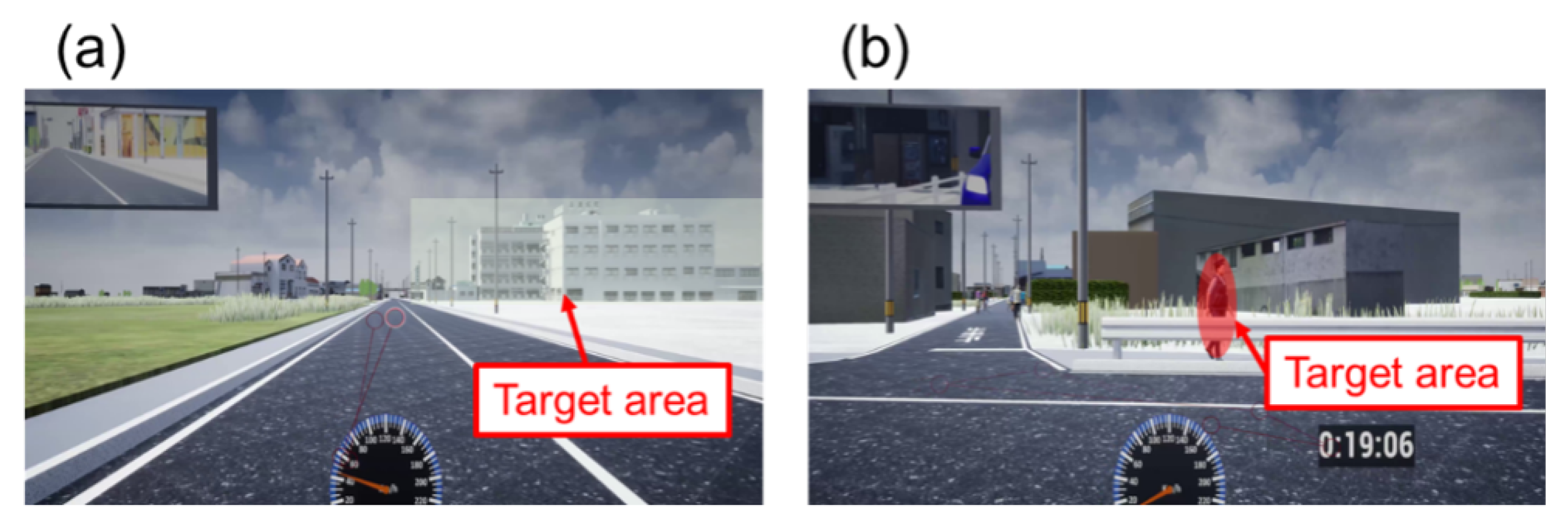
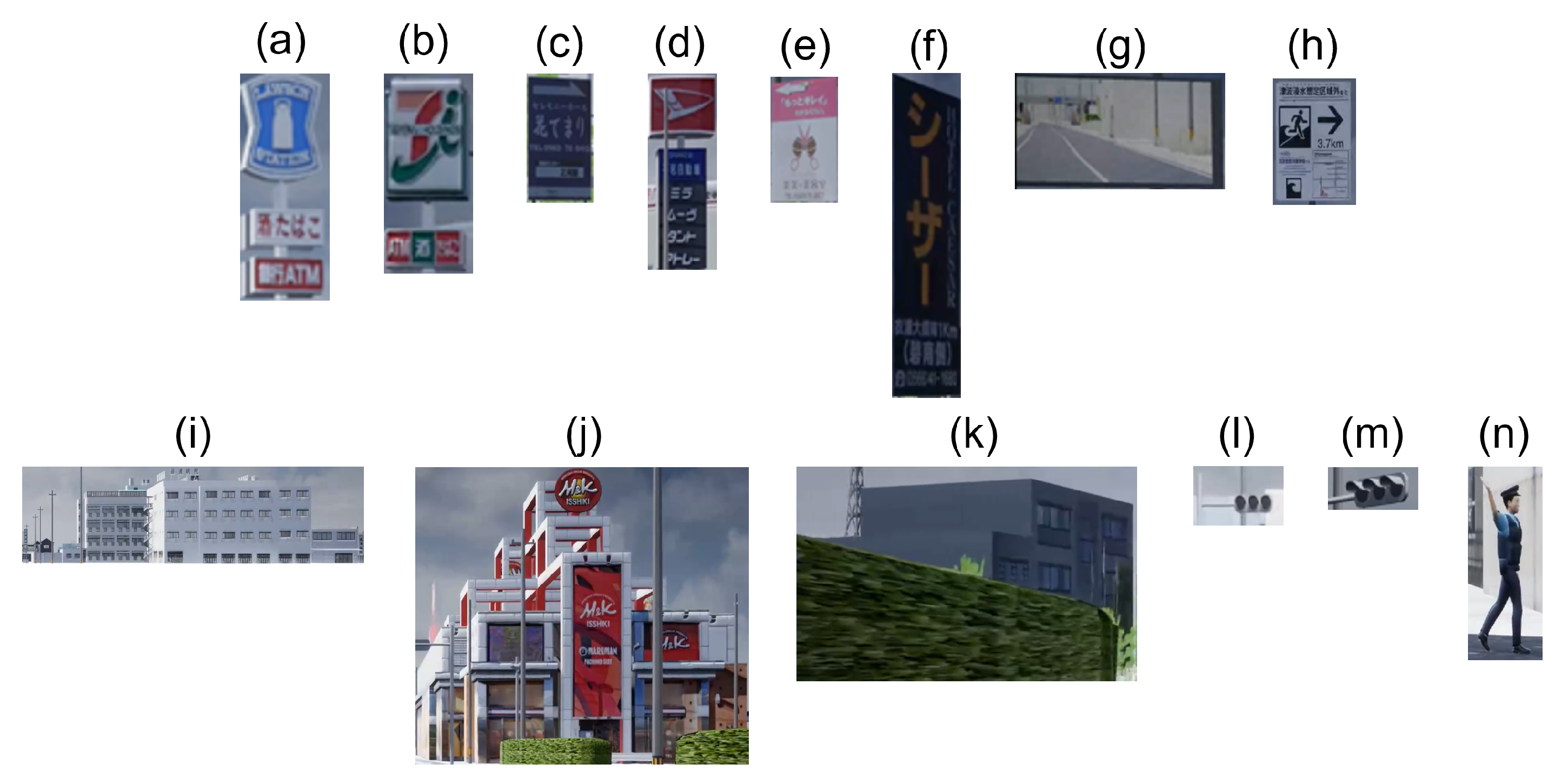



| CPU | IntelCoreTMi9-9900K |
| GPU | NVIDIA®GeForce RTXTM 2080 SUPER |
| Memory | 16GB DDR4 SDRAM (PC4-21300, 8GB ×2) |
| Participants | Age | Gender | Route | Participants | Age | Gender | Route |
|---|---|---|---|---|---|---|---|
| A | 53 | F | 1 | M | 71 | M | 2 |
| B | 54 | M | 1 | N | 34 | M | 2 |
| C | 53 | F | 1 | O | 30 | M | 2 |
| D | 64 | F | 2 | P | 45 | M | 2 |
| E | 23 | M | 2 | Q | 55 | M | 2 |
| F | 30 | M | 1 | R | 35 | M | 1 |
| G | 66 | M | 2 | S | 30 | M | 1 |
| H | 42 | F | 2 | T | 29 | F | 2 |
| I | 71 | M | 1 | U | 72 | M | 2 |
| J | 21 | F | 1 | V | 69 | F | 2 |
| K | 67 | M | 2 | W | 46 | M | 1 |
| L | 52 | M | 1 | X | 50 | M | 1 |
| Y | 35 | F | 1 |
| Gazing Target | Name | Design | Location |
|---|---|---|---|
| Signboard | Convenience store sign | (a) | ⑫ |
| (b) | ⑮ | ||
| Store sign | (c) | ⑬ | |
| (d) | ⑯ | ||
| (e) | ⑲ | ||
| (f) | ⑧ | ||
| Inner rearview mirror | (g) | Always showing only evacuation by car | |
| Evacuation sign | (h) | ⑤ | |
| Prominent Building and emergency refuge | Hospital | (i) | ④ |
| Pachinko parlor | (j) | ⑰ | |
| Company building | (k) | ⑨ | |
| Traffic signal | Traffic signal (front) | (l) | ③, ⑦, ⑪, ⑭, ⑱ |
| Traffic signal (right) | (m) | ③ (only route 1), ⑦, ⑰ | |
| Police officer guiding the route | (n) | ①, ②, ⑥, ⑩, ⑰ |
| Participants | Age | Gender | Comment |
|---|---|---|---|
| A | 72 | F | The experiment reminded me of 10 years ago (when the Great East Japan Earthquake occurred)… I was thrilled. I was impatient. I don’t want to regret it later, so I think using a car is an on-the-spot decision for evacuation depending on the situation. |
| B | 62 | F | Cars can go far. On foot, you can walk up to the footbridge. Which is better depends on the situation. If there is a traffic jam, there is nothing you can do, so then you go to a higher place. |
| C | 65 | F | If the evacuation site is near, I will evacuate on foot. It may be better to evacuate on foot because of traffic jams, etc. There is a difference in the evacuation of able-bodied people and non-able-bodied people to escape. It is difficult for non-able-bodied people. Be kind to these people. We need to be kind and help those around us and evacuate together. |
| D | 69 | M | The experiment reminded me of the time of the Great East Japan Earthquake. Differs from actual driving in terms of speed, etc. Basically evacuate on foot. Talk to able-bodied and non-able-bodied people. Flexible decision making is necessary. |
| E | 71 | M | Even though it was a simulation, it was upsetting and I was speeding. If my legs are healthy, I will evacuate on foot. If it is crowded, even if I am told I can escape here, I can’t evacuate by car. If there is a high place at or near the target, I will leave the car and escape. |
| F | 71 | F | I drove wrong route … there was a sense of urgency. First, escape by car to the mountains, etc., and make a quick decision to flee as soon as possible. Head for a high place nearby. |
| G | 54 | F | I was puzzled by the operation of the simulator case by case. If I have something expensive, I will walk. |
| H | 70 | F | Evacuation on foot is better. I can move freely. |
| I | 82 | M | It was difficult to operate the simulator. Depends on location and situation. Evacuate by car if possible. Self-judgment and experience are important. Always simulate and share information about evacuation. |
| J | 73 | M | Better to evacuate on foot. Either way, evacuate to higher ground. |
| Target Area | Evacuation by Car | Evacuation on Foot |
|---|---|---|
| Signboard | 0.384 (↓), n.s. | 0.684 (↓), n.s. |
| Inner rearview mirror | 0.811 (↑), n.s. | – |
| Evacuation sign | 0.980 (↓), n.s. | 0.771 (↓), n.s. |
| Prominent building and emergency refuge | 0.979 (↑), n.s. | 0.884 (↑), n.s. |
| Traffic signal | 0.064 (↑), n.s. | 0.816 (↑), n.s. |
| Police officer guiding the route | 0.405 (↓), n.s. | 0.203 (↓), n.s. |
Disclaimer/Publisher’s Note: The statements, opinions and data contained in all publications are solely those of the individual author(s) and contributor(s) and not of MDPI and/or the editor(s). MDPI and/or the editor(s) disclaim responsibility for any injury to people or property resulting from any ideas, methods, instructions or products referred to in the content. |
© 2025 by the authors. Licensee MDPI, Basel, Switzerland. This article is an open access article distributed under the terms and conditions of the Creative Commons Attribution (CC BY) license (https://creativecommons.org/licenses/by/4.0/).
Share and Cite
Arakawa, T.; Obayashi, F.; Kobayashi, K.; Itamiya, T.; Uno, S.; Yamabe, S.; Suzuki, T.; Tajima, J. Simulation-Based Tsunami Evacuation Training Framework Aimed at Avoiding the Negative Consequences of Using Cars. Geosciences 2025, 15, 364. https://doi.org/10.3390/geosciences15090364
Arakawa T, Obayashi F, Kobayashi K, Itamiya T, Uno S, Yamabe S, Suzuki T, Tajima J. Simulation-Based Tsunami Evacuation Training Framework Aimed at Avoiding the Negative Consequences of Using Cars. Geosciences. 2025; 15(9):364. https://doi.org/10.3390/geosciences15090364
Chicago/Turabian StyleArakawa, Toshiya, Fumiaki Obayashi, Kazunobu Kobayashi, Tomoki Itamiya, Shintaro Uno, Shigeyuki Yamabe, Takahiro Suzuki, and Jun Tajima. 2025. "Simulation-Based Tsunami Evacuation Training Framework Aimed at Avoiding the Negative Consequences of Using Cars" Geosciences 15, no. 9: 364. https://doi.org/10.3390/geosciences15090364
APA StyleArakawa, T., Obayashi, F., Kobayashi, K., Itamiya, T., Uno, S., Yamabe, S., Suzuki, T., & Tajima, J. (2025). Simulation-Based Tsunami Evacuation Training Framework Aimed at Avoiding the Negative Consequences of Using Cars. Geosciences, 15(9), 364. https://doi.org/10.3390/geosciences15090364





